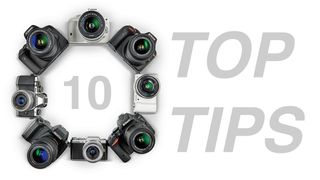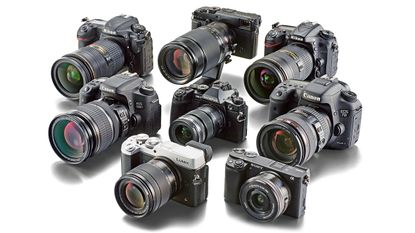There are plenty of photography tips online but they're often geared to either total amateurs or to people with beards who have notebooks full of exposure times and optimum f-stop calculations.
We asked our chums at Jessops Academy for ten tips that would suit those who already know which way up to hold their camera, and are aware that increasing ISO can be a good idea in darker locations, but who wouldn't neccesarily call themselves David Bailey Mk II. This is what they told us, with 10 tips geared around summer photographic staples such as sports, wildlife and heavy rain.
• You'll now be wanting to know what the best cameras are…
• Review your digital snaps on the best TVs available to humanity…

• If you're shooting a fast paced moment…
Such as a tennis player in action, or a streaker at a test match, your subjects will move through the frame in a similar way each time and it is essential for you to get the right timing. Firstly, frame up and try a couple of practice shots before the big moment and then place your subject on the points where the “rule of thirds” lines intersect and you're guaranteed great composition.
Take things to the next level by ensuring they're moving into the “space” created in your shot – so, if you place them on the right hand side of your photo, have them facing towards the space on the left.
• For action shots, a long lens is essential.
Opt for something in the 100-400mm region. If you can swing for a long prime lens, so much the better: you'll be able to create pin-sharp action portraits that perfectly capture the drama unfolding before you.
A wide-angle or fish-eye lens will also aid your creativity and enable you to shoot the whole of the field in a single frame.
• Try not to put your horizon in the middle of the frame.
This can often confuse your camera's exposure. Instead try to utilise the rule of thirds and place your horizon on the top or bottom third. This helps with your exposure and is also more pleasing to the eye.
• Don't let the weather ruin your photography.
Use those, ahem, 'beautiful' raindrops to your advantage. Raindrops are one of the most challenging subjects to point your camera at but if you allow yourself to get super-close, you can use them as a lens to capture the scene beyond, or try reflecting light in their curved surfaces.
They're also good from the outside looking in – if you find yourself staring out of a rain-covered window, then have a go at capturing it on camera. A light background will make the raindrops appear as dark-outlined circles, where-as a dark background will turn them into glowing orbs.
• Want to freeze a moment?
A fast shutter speed is essential to capture the action in focus. Make use of all the technology packed into your camera and let it do all the work for you; all that is necessary for you is to raise your camera and press the shutter to secure your shot.
You probably have a Sports Mode or similar tucked away in your camera's semi-automatic settings. Experiment with that and see if you get the effect you're looking for.
• For capturing landscape images…
A wide-angle lens such as a 10-20mm or similar will allow you to capture the entirety of sweeping landscapes in single shots: plus a mid-range zoom like a 24-70mm gives you flexibility for framing more tightly. Having the right equipment can make all the difference.
• Shooting wildlife.
Speaking of equipment, you'll be wanting a few specialist bits of kit for this. Firstly, a DSLR or mirrorless camera to give you the creative flexibility and picture quality required to make the most of your superb subjects.
The camera alone isn't enough to get the perfect shot, however. You'll also need a long telephoto lens, such as a 75-300mm or 100-400mm, to get you close to your subjects without you startling them, or them killing you.
• Take the perfect selfie.
Make use of the burst mode. This setting's often overlooked, but if you need to capture a photo in a hurry then it could be the difference between a blinker and a keeper. Switch on burst and take as many frames as your camera will let you before it has to buffer: then you can check through your shots and pick your favourite.
• Portrait photography.
Consider the type of lens you are using. A 50mm lens will normally have a very wide maximum aperture (like f/2.8 or even f/1.8) which will give you beautiful background blur in your images – while a 70-200mm or similar will allow you to take perfect portraits from a distance, without crowding your subject.
• Photographing flowers.
Yeah, it's a bit cliché. But they can look so perfect in the summer sun.
Try moving yourself so the sun's rays are shining through the flowers' petals and leaves: this effect is called contre-jour lighting (French for “against daylight”) and will make them glow beautifully with light. It's a great technique for showing off the gorgeous colours that these seasonal flowers have to offer.
Images courtesy of Digital Camera.
About Jessops Academy:
Jessops Academy aims to help you get the most out of your camera. Its team members are all photographers, trained to a very high standard.
Courses and 'experiences' available include: Level 1 and Level 2, Macro Photography, Big Cats, Wedding Photography, City Photography, British Wildlife Experience and even a Safari photography trip to Namibia.
For the Level 1 course, you just need to know how to hold a camera; the Academy team will help with the rest. The tips here are more Level 2.
Jessops Academy Courses are easy to book and are available at lots of different locations around the UK; not just London.
Prices start from £119 for a full day (10am-4pm) and can be booked online.



